| Listing 1 - 10 of 31 | << page >> |
Sort by
|
Book
Year: 2000 Publisher: Amsterdam North-Holland
Abstract | Keywords | Export | Availability | Bookmark
 Loading...
Loading...Choose an application
- Reference Manager
- EndNote
- RefWorks (Direct export to RefWorks)
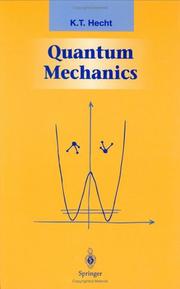
ISBN: 0387989196 1461270723 1461212723 Year: 2000 Publisher: New York, N.Y. Springer
Abstract | Keywords | Export | Availability | Bookmark
 Loading...
Loading...Choose an application
- Reference Manager
- EndNote
- RefWorks (Direct export to RefWorks)
Intended for beginning graduate students, this text takes the reader from the familiar coordinate representation of quantum mechanics to the modern algebraic approach, emphsizing symmetry principles throughout. After an introduction of the basic postulates and techniques, the book discusses time-independent perturbation theory, angular momentum, identical particles, scattering theory, and time-dependent perturbation theory. It concludes with several lectures on relativistic quantum mechanics and on many-body theory.
Quantum mechanics. Quantumfield theory --- Quantum theory. --- Théorie quantique --- Théorie quantique --- Mechanics. --- Classical Mechanics. --- Classical mechanics --- Newtonian mechanics --- Physics --- Dynamics --- Quantum theory
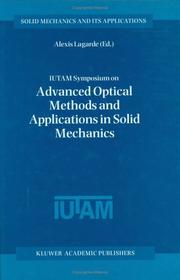
ISBN: 128020513X 9786610205134 0306469480 0792366042 Year: 2000 Publisher: New York : Kluwer Academic,
Abstract | Keywords | Export | Availability | Bookmark
 Loading...
Loading...Choose an application
- Reference Manager
- EndNote
- RefWorks (Direct export to RefWorks)
The request to organize under its patronage at Poitiers in 1998 a Symposium entitled “Advanced Optical Methods and Applications in Solid Mechanics” by the International Union of Theoretical and Applied Mechanics (I.U.T.A.M.) was well received for the following two reasons. First, for nearly 20 years no Symposium devoted to optical methods in solids had been organized. Second, recent advances in digital image processing provided many new applications which are described in the following. We have the honour to present here the proceedings of this Symposium. st th The Symposium took place from august 31 to September 4 at the Institut International de la Prospective in Futuroscope near Poitiers. A significant number of internationally renowned specialists had expressed their wish to participate in this meeting. The Scientific Committee proposed 16 general conferences and selected 33 regular lectures and 17 poster presentations. Papers corresponding to posters are not differentiated in the proceedings from those that were presented orally. It is worth noting that a total of 80 participants, representing 16 countries, registered for this symposium.. The Scientific Committee deserves praise for attracting a significant number of young scientists, both as authors and as participants. Let us add our warm acknowledgements to Professor J.W. Dally and to Professor A.S. Kobayashi who, throughout the symposium preparation time, brought us valuable help.
Strength of materials --- Optical measurements --- Photoelasticity --- Image analysis --- Mechanics. --- Classical Mechanics. --- Classical mechanics --- Newtonian mechanics --- Physics --- Dynamics --- Quantum theory --- Photoelastic method --- Elasticity --- Physical optics
Year: 2000 Publisher: Kapellen Pelckmans
Abstract | Keywords | Export | Availability | Bookmark
 Loading...
Loading...Choose an application
- Reference Manager
- EndNote
- RefWorks (Direct export to RefWorks)
Didactics of physics --- Didactics of secundary education --- Classical mechanics. Field theory --- Thermodynamics --- Electricity --- Nuclear physics --- thermodynamica --- elektriciteit --- radioactiviteit --- fysica --- elektromagnetisme
Book
Year: 2000 Publisher: Kapellen Pelckmans
Abstract | Keywords | Export | Availability | Bookmark
 Loading...
Loading...Choose an application
- Reference Manager
- EndNote
- RefWorks (Direct export to RefWorks)
Didactics of physics --- Didactics of secundary education --- Classical mechanics. Field theory --- Thermodynamics --- Electricity --- Nuclear physics --- thermodynamica --- elektriciteit --- radioactiviteit --- fysica --- elektromagnetisme
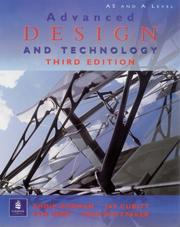
ISBN: 0582328314 Year: 2000 Publisher: Harlow Pearson
Abstract | Keywords | Export | Availability | Bookmark
 Loading...
Loading...Choose an application
- Reference Manager
- EndNote
- RefWorks (Direct export to RefWorks)
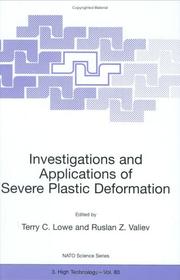
ISBN: 0792362802 0792362810 9401140626 Year: 2000 Publisher: Dordrecht : Kluwer,
Abstract | Keywords | Export | Availability | Bookmark
 Loading...
Loading...Choose an application
- Reference Manager
- EndNote
- RefWorks (Direct export to RefWorks)
Material processing techniques that employ severe plastic deformation have evolved over the past decade, producing metals, alloys and composites having extraordinary properties. Variants of SPD methods are now capable of creating monolithic materials with submicron and nanocrystalline grain sizes. The resulting novel properties of these materials has led to a growing scientific and commercial interest in them. They offer the promise of bulk nanocrystalline materials for structural; applications, including nanocomposites of lightweight alloys with unprecedented strength. These materials may also enable the use of alternative metal shaping processes, such as high strain rate superplastic forming. Prospective applications for medical, automotive, aerospace and other industries are already under development.
Plasticity --- Deformations (Mechanics) --- Congresses --- Metals. --- Mechanics. --- Mechanics, Applied. --- Materials science. --- Metallic Materials. --- Theoretical and Applied Mechanics. --- Characterization and Evaluation of Materials. --- Classical Mechanics. --- Material science --- Physical sciences --- Applied mechanics --- Engineering, Mechanical --- Engineering mathematics --- Classical mechanics --- Newtonian mechanics --- Physics --- Dynamics --- Quantum theory --- Metallic elements --- Chemical elements --- Ores --- Metallurgy --- Microstructure --- Plastic deformation --- Process control
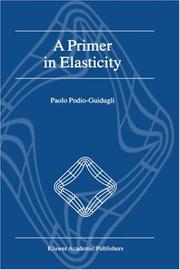
ISBN: 0792366425 9048155924 9401705941 Year: 2000 Publisher: Dordrecht : Kluwer,
Abstract | Keywords | Export | Availability | Bookmark
 Loading...
Loading...Choose an application
- Reference Manager
- EndNote
- RefWorks (Direct export to RefWorks)
I want to thank R. L. Fosdick, M. E. Gurtin and W. O. Williams for their detailed criticism of the manuscript. I also thank F. Davi, M. Lembo, P. Nardinocchi and M. Vianello for valuable remarks prompted by their reading of one or another of the many previous drafts, from 1988 to date. Since it has taken me so long to bring this writing to its present form, many other colleagues and students have episodically offered useful comments and caught mistakes: a list would risk to be incomplete, but I am heartily grateful to them all. Finally, I thank V. Nicotra for skillfully transforming my hand sketches into book-quality figures. P. PODIO-GUIDUGLI Roma, April 2000 Journal of Elasticity 58: 1-104,2000. 1 P. Podio-Guidugli, A Primer in Elasticity. © 2000 Kluwer Academic Publishers. CHAPTER I Strain 1. Deformation. Displacement Let 8 be a 3-dimensional Euclidean space, and let V be the vector space associated with 8. We distinguish a point p E 8 both from its position vector p(p):= (p-o) E V with respect to a chosen origin 0 E 8 and from any triplet (~1, ~2, ~3) E R3 of coordinates that we may use to label p. Moreover, we endow V with the usual inner product structure, and orient it in one of the two possible manners. It then makes sense to consider the inner product a .
Elasticity --- Elasticité --- Elasticité --- Mechanics. --- Mathematical models. --- Mechanics, Applied. --- Applied mathematics. --- Engineering mathematics. --- Classical Mechanics. --- Mathematical Modeling and Industrial Mathematics. --- Solid Mechanics. --- Applications of Mathematics. --- Engineering --- Engineering analysis --- Mathematical analysis --- Applied mechanics --- Engineering, Mechanical --- Engineering mathematics --- Models, Mathematical --- Simulation methods --- Classical mechanics --- Newtonian mechanics --- Physics --- Dynamics --- Quantum theory --- Mathematics --- Élasticité
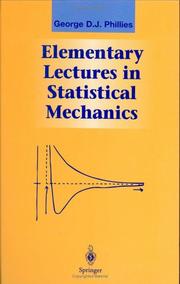
ISBN: 0387989188 1461270685 1461212642 Year: 2000 Publisher: New York (N.Y.) Springer
Abstract | Keywords | Export | Availability | Bookmark
 Loading...
Loading...Choose an application
- Reference Manager
- EndNote
- RefWorks (Direct export to RefWorks)
This volume is based on courses on Statistical Mechanics which I have taught for many years at the Worcester Polytechnic Institute. My objective is to treat classical statistical mechanics and its modem applications, especially interacting particles, correlation functions, and time-dependent phenomena. My development is based primarily on Gibbs's ensemble formulation. Elementary Lectures in Statistical Mechanics is meant as a (relatively sophis ticated) undergraduate or (relatively straightforward) graduate text for physics students. It should also be suitable as a graduate text for physical chemistry stu dents. Physicists may find my treatment of algebraic manipulation to be more explicit than some other volumes. In my experience some of our colleagues are perhaps a bit over-enthusiastic about the ability or tendency of our students to complete gaps in the derivations. I emphasize a cyclic development of major themes. I could have begun with a fully detailed formal treatment of ensemble mechanics, as found in Gibbs's volume, and then given material realizations. I instead interleave formal discussions with simple concrete models. The models illustrate the formal definitions. The approach here gives students a chance to identify fundamental principles and methods before getting buried in ancillary details.
Statistical mechanics. --- Statistical mechanics --- Mechanics --- Mechanics, Analytic --- Quantum statistics --- Statistical physics --- Thermodynamics --- Mechanics. --- Statistics . --- Classical Mechanics. --- Statistics for Engineering, Physics, Computer Science, Chemistry and Earth Sciences. --- Classical mechanics --- Newtonian mechanics --- Physics --- Dynamics --- Quantum theory --- Statistical analysis --- Statistical data --- Statistical methods --- Statistical science --- Mathematics --- Econometrics
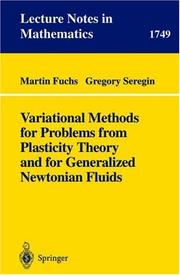
ISBN: 3540413979 3540444424 9783540413974 Year: 2000 Volume: 1749 Publisher: Berlin ; Heidelberg ; New York Springer Verlag
Abstract | Keywords | Export | Availability | Bookmark
 Loading...
Loading...Choose an application
- Reference Manager
- EndNote
- RefWorks (Direct export to RefWorks)
Variational methods are applied to prove the existence of weak solutions for boundary value problems from the deformation theory of plasticity as well as for the slow, steady state flow of generalized Newtonian fluids including the Bingham and Prandtl-Eyring model. For perfect plasticity the role of the stress tensor is emphasized by studying the dual variational problem in appropriate function spaces. The main results describe the analytic properties of weak solutions, e.g. differentiability of velocity fields and continuity of stresses. The monograph addresses researchers and graduate students interested in applications of variational and PDE methods in the mechanics of solids and fluids.
Plasticity. --- Newtonian fluids. --- Calculus of variations. --- Calcul des variations --- Calculus of variations --- Newtonian fluids --- Plasticiteit --- Plasticity --- Plasticité --- Variatieberekening --- Applied mathematics. --- Engineering mathematics. --- Mechanics. --- Mathematical physics. --- Partial differential equations. --- Applications of Mathematics. --- Classical Mechanics. --- Theoretical, Mathematical and Computational Physics. --- Partial Differential Equations. --- Partial differential equations --- Physical mathematics --- Physics --- Classical mechanics --- Newtonian mechanics --- Dynamics --- Quantum theory --- Engineering --- Engineering analysis --- Mathematical analysis --- Mathematics
| Listing 1 - 10 of 31 | << page >> |
Sort by
|

 Search
Search Feedback
Feedback About UniCat
About UniCat  Help
Help News
News